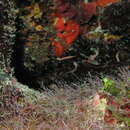en
names in breadcrumbs


Lucayablennius zingaro, the arrow blenny, is a species of chaenopsid blenny found in coral reefs around the Bahamas and the Caribbean, in the western central Atlantic ocean. It can reach a maximum length of 3.8 centimetres (1.5 in) TL. This species is the only known member of its genus.[2] They are red to reddish brown in color with white stripes that fade to yellow towards the tail. The tail is always held at a curve or bend and typically has three black spots on the dorsal side. Unlike most blennys, the arrow blenny does not perch its self on rocks or coral. Rather, it waits floating in the water column before swooping down to catch unsuspecting zooplankton.
Lucayablennius zingaro, the arrow blenny, is a species of chaenopsid blenny found in coral reefs around the Bahamas and the Caribbean, in the western central Atlantic ocean. It can reach a maximum length of 3.8 centimetres (1.5 in) TL. This species is the only known member of its genus. They are red to reddish brown in color with white stripes that fade to yellow towards the tail. The tail is always held at a curve or bend and typically has three black spots on the dorsal side. Unlike most blennys, the arrow blenny does not perch its self on rocks or coral. Rather, it waits floating in the water column before swooping down to catch unsuspecting zooplankton.